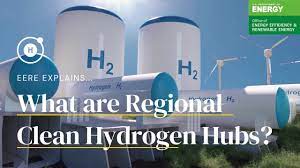
It’s hard to believe that such significant amounts of hydrogen will find application in all these regional settings?
Presentation of Article by William Driscoll, PV Magazine, 10/19/22
Teams across the United States plan to compete for $7 billion in U.S Department of Energy funding for up to ten regional clean hydrogen hubs.
Regional hydrogen hubs are a key element of DOE’s draft National Clean Hydrogen Strategy and Roadmap. DOE’s strategy aims to advance the use of clean hydrogen in industry, heavy-duty transportation, and long-duration energy storage, through regional hubs and by driving innovation, scale and lower costs across the hydrogen supply chain.
In one publicly announced hub project, six Northeastern states and more than 60 clean hydrogen “ecosystem partners,” including EDP Renewables North America, have joined a team led by New York to seek DOE funding. The team aims to build “a robust and connected clean hydrogen market across the Northeast,” said New York Governor Kathy Hochul.
In Texas, the Port of Corpus Christi “has everything we need for a hydrogen hub,” said Jacob Susman, co-founder and CEO of Ambient Fuels. He spoke at September’s RE+ conference on using hydrogen to decarbonize the production of ammonia, chemicals, steel and concrete. The Port of Corpus Christi Authority, Apex Clean Energy, and other parties have been working since February on a green fuels hub.
California’s team promoting a renewable hydrogen hub has grown to a network of more than 100 partners.
Other hydrogen hub proposals, as reported in news stories, are in development for the Great Plains states, in the Midwest, centered in West Virginia, and extending from Oklahoma to Louisiana.
Jigar Shah, director of DOE’s Loan Programs Office, said on Twitter that his office has received “many” hydrogen applications “and looks forward to evaluating all of them. We also need to emphasize that the ecosystem is dominated by growth companies exporting hydrogen. We need to develop more domestic demand for clean hydrogen.”
For regional clean hydrogen hub projects seeking DOE funding, concept papers are due to DOE by November 7.
What is clean?
Hydrogen can be produced from natural gas, or from water via electrolysis. “Green” hydrogen is produced through electrolysis powered by renewable energy.
DOE has proposed an initial clean hydrogen production standard of 4 kg CO2-equivalent per kg of hydrogen, “to encourage low-carbon hydrogen production from diverse feedstocks and using state-of-the-art technologies that are expected to be deployable at scale today.”
“For example,” the draft standard says, “a steam methane reformer with ~95% carbon capture and sequestration could achieve ~4.0 kgCO2e/kgH2 lifecycle emissions by using electricity that represents the average U.S. grid mix and ensuring that upstream methane emissions do not exceed 1%. Electrolysis systems that source about 15% of their electricity from the grid and the remainder from clean energy sources could also achieve ~4.0 kgCO2e/kgH2 lifecycle emissions.”
DOE says its proposed clean hydrogen standard of 4.0 kgCO2e/kgH2 may be subject to revision based on stakeholder feedback, with feedback sought by October 20. DOE also noted that “other policies and market forces may incentivize deployments that are cleaner than the targets established.” Once DOE finalizes the standard, it may update the standard within five years.
#######+++++++#######+++++++########
SEE ALSO: U.S. Department of Energy Clean Hydrogen Production Standard (CHPS) Draft Guidance:
https://www.hydrogen.energy.gov/pdfs/clean-hydrogen-production-standard.pdf

{ 1 comment… read it below or add one }
Chevron and partners study US hydrogen project
By Polly Martin, Petroleum Economist, October 2022
The Gulf Coast has existing infrastructure to supply domestic industrial clusters and exports to international markets.
US oil major Chevron, industrial gases firm Air Liquide, multinational chemicals company Lyondell Basell and Germany energy firm Uniper have announced their intention to launch a joint study to evaluate and potentially advance the development of a hydrogen and ammonia production facility along the US Gulf Coast.
The four firms will assess the potential for producing both blue and green forms of hydrogen to supply end-use markets—including ammonia, petrochemicals, power and mobility.
The Gulf Coast presents advantages for hydrogen project development, such as existing infrastructure for transport to domestic industrial clusters and export to Europe and Asia.
https://pemedianetwork.com/hydrogen-economist/articles/strategies-trends/2022/chevron-and-partners-study-us-hydrogen-project/